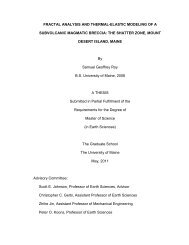Jumars, P.A. - University of Maine
Jumars, P.A. - University of Maine
Jumars, P.A. - University of Maine
Create successful ePaper yourself
Turn your PDF publications into a flip-book with our unique Google optimized e-Paper software.
NEW SPECIES OF NORTH PACIFIC DORVILLEID POLYCHAETES 127<br />
a falcate and plate-like denticle pair . This denticle is the farthest posterior <strong>of</strong><br />
the seven in each series . The mandible pieces (Fig . 12G) are each weakly<br />
bifurcate anteriorly and are denticulate both anteriorly and medially .<br />
The gut is filled with dark, particulate matter .<br />
Remarks . O . hadalis differs from the other species <strong>of</strong> the genus in its ridged,<br />
eyeless prostomium, its placement <strong>of</strong> antennae and palps, and its lack <strong>of</strong> dorsal<br />
cirri . It is the only species <strong>of</strong> Ophryotrocha in which some denticles can be<br />
distinctly assigned to the superior and inferior rows .<br />
Distribution . The species is known from a single sample at 7298 m in the<br />
Aleutian Trench . It is named for this hadal distribution .<br />
Genus Parophryotrocha Hartmann-Schroder, 1971<br />
Type-species . Ophryotrocha (?) isochaeta Eliason, 1962 .<br />
Diagnosis . The prostomium is roughly hemispherical . Antennae and palps are<br />
entirely lacking . Dorsal and ventral cirri are absent . Only simple, acicular setae<br />
are present . Both pairs <strong>of</strong> carriers and all four basal plates are fused in an<br />
ice-tong shape . Four rows <strong>of</strong> denticles remain .<br />
Remarks . Parophryotrocha is monotypic .<br />
Parophryotrocha isochaeta (Eliason, 1962)<br />
Ophryotrocha (?) isochaeta Eliason, 1962 : 260, fig . 16 .<br />
Parophryotrocha isochaeta : Hartmann-Schroder, 1971 : 260 .<br />
Material examined . None .<br />
Description . Eliason 's (1962) and Hartmann-Schroder's (1971) descriptions<br />
<strong>of</strong> the jaw parts <strong>of</strong> this species reveal a pattern homologous with that in<br />
Ophryotrocha-fused carriers and basal plates with falcate denticles in the<br />
short, dorsolateral row and plate-like denticles in the more medioventral row .<br />
Distribution . P. isochaeta is known only from the Skagerrak in 637-650 m .<br />
Genus Apophryotrocha gen . nov .<br />
Type-species . Apophryotrocha mutabiliseta sp . nov .<br />
Diagnosis . The prostomium is roughly hemispherical . Antennae are very long<br />
and cirriform ; palps are well developed but are shorter and subulate . Dorsal<br />
cirri are without aciculae. Setae are <strong>of</strong> two types : (1) capillary and (2) compound<br />
heterogomph . Both pairs <strong>of</strong> carriers and all four basal plates are fused in<br />
an ice-tong shape . No free denticles are found .<br />
Remarks. The genus is monotypic and is named for its presumed close<br />
affinities with Ophryotrocha . It is distinguished from Ophryotrocha because<br />
the long antennae and palps and simple jaws <strong>of</strong> Apophryotrocha imply a mode<br />
<strong>of</strong> life different from that <strong>of</strong> Ophryotrocha (Westhide, 1971 ; Akesson, 1967) .<br />
The reduced jaws would be incompatible with a surface-scraping existence . The<br />
intricate structure <strong>of</strong> the compound setae and the paucity <strong>of</strong> capillary setae is<br />
also unlike the condition in Ophryotrocha .
















